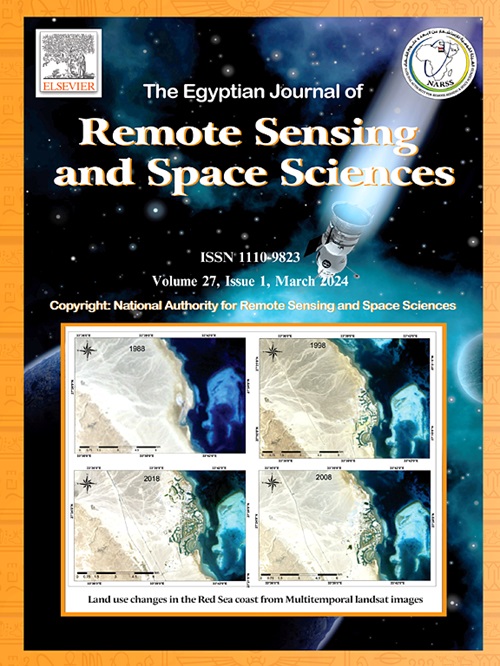Quantitative assessment of spatiotemporal variability in air quality within the Amman-Zarqa urban Area, Jordan
IF 3.7
3区 地球科学
Q2 ENVIRONMENTAL SCIENCES
Egyptian Journal of Remote Sensing and Space Sciences
Pub Date : 2025-06-26
DOI:10.1016/j.ejrs.2025.06.002
引用次数: 0
Abstract
Many factors influence the concentration of air pollutants, particularly Carbon Monoxide (CO) and Nitrogen Dioxide (NO2). This research aims to study the spatiotemporal variability of CO and NO2 on a monthly basis in 2021 and to investigate the relationship between these gases and both natural and anthropogenic factors across seven districts of the Amman-Zarqa urban environment of Jordan. To understand these relationships using regression analysis and the mean relative difference, the CO and NO2 data extracted from The TROPOspheric Monitoring Instrument (TROPOMI) which is the satellite instrument on board the Copernicus Sentinel-5 Precursor satellite. The results of the mean relative difference indicated that the spatial concentration of CO in the Zarqa districts is higher than in the Amman districts due to industrial activities and low vegetation cover. In contrast, NO2 is primarily concentrated in the Marka and Qasaba Amman districts than the other districts, which have the highest traffic and population density in the study area. Regression analysis reveals that while the concentration of CO is positively correlated with Land Surface Temperature (LST), Wind Speed (WS), and Wind Direction (WD), with r2 values of approximately 0.62, 0.53, and 0.48 respectively. Conversely, a negative relationship is observed with digital Elevation Model (DEM), Normalized Difference Vegetation Index (NDVI), and Relative Humidity (RH). For NO2, a weak positive correlation with the Built-Up (BU) index and Normalized Difference Built-Up Index (NDBI) has been noticed, along with a modest negative correlation with LST, DEM, WS, RH, WD, and NDVI.
约旦安曼-扎尔卡市区空气质量时空变异的定量评估
许多因素影响空气污染物的浓度,特别是一氧化碳(CO)和二氧化氮(NO2)。本研究旨在研究2021年约旦安曼-扎尔卡城市环境7个区CO和NO2的逐月时空变化,并探讨这些气体与自然和人为因素之间的关系。利用哥白尼哨兵-5前驱卫星上的对流层监测仪器(TROPOMI)采集的CO和NO2数据,利用回归分析和平均相对差来理解这些关系。平均相对差异结果表明,由于工业活动和低植被覆盖,Zarqa地区CO的空间浓度高于Amman地区。NO2主要集中在Marka区和Qasaba Amman区,是研究区交通和人口密度最高的两个区。回归分析表明,CO浓度与地表温度(LST)、风速(WS)和风向(WD)呈正相关,r2分别约为0.62、0.53和0.48。与数字高程模型(DEM)、归一化植被指数(NDVI)和相对湿度(RH)呈负相关。NO2与建成度指数(BU)和归一化差异建成度指数(NDBI)呈弱正相关,与LST、DEM、WS、RH、WD和NDVI呈适度负相关。
本文章由计算机程序翻译,如有差异,请以英文原文为准。
求助全文
约1分钟内获得全文
求助全文
来源期刊
CiteScore
8.10
自引率
0.00%
发文量
85
审稿时长
48 weeks
期刊介绍:
The Egyptian Journal of Remote Sensing and Space Sciences (EJRS) encompasses a comprehensive range of topics within Remote Sensing, Geographic Information Systems (GIS), planetary geology, and space technology development, including theories, applications, and modeling. EJRS aims to disseminate high-quality, peer-reviewed research focusing on the advancement of remote sensing and GIS technologies and their practical applications for effective planning, sustainable development, and environmental resource conservation. The journal particularly welcomes innovative papers with broad scientific appeal.

 求助内容:
求助内容: 应助结果提醒方式:
应助结果提醒方式:


